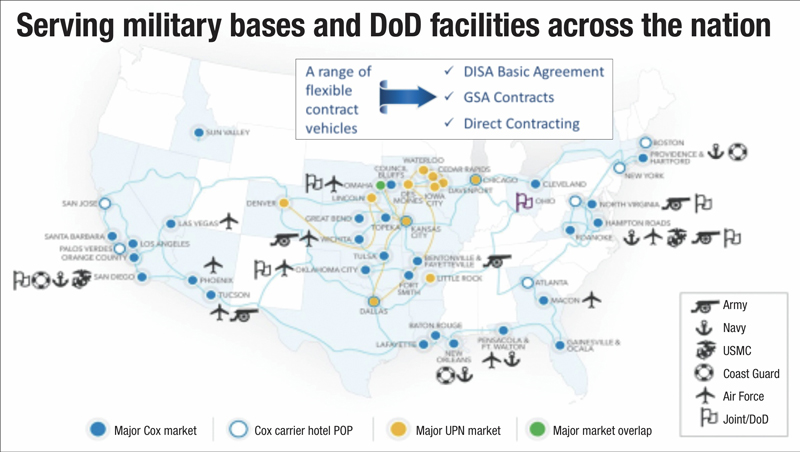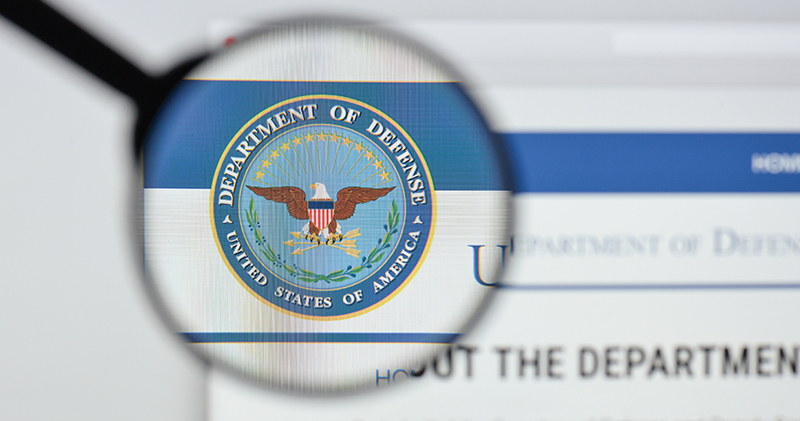Cox Business, The Best Kept Secret
By Cateena Powers
When the Department of Defense (DoD) seeks to upgrade and expand their communications network globally, which telecommunications provider is the likely choice? Most of the legacy Bell/telecom providers come to mind, including the incumbent local exchange carriers (ILEC) which have been a communication staple since the breakup of AT&T in 1982.
In our quickly transforming world how does the DoD gain the route and carrier diversity it needs to keep the Defense Information Systems Network (DISN) operational 24 hours a day and 7 days each week? The Dept. of Defense depends on reliable and constant communication to execute the mission and to protect and defend Americans and those in their charge. Enter cable operators! Once thought to be just the cable provider for homeowners and small businesses, operators like Cox Communications have spent many years building a resilient national network to support large scale government and enterprise customers. Cox Business is a division of Cox Communications that provides service to over 450,000 business customers. This includes traditional mom and pop shops, school systems, higher education and Fortune 500 enterprises. Finally, my area of focus: state, local, and federal government agencies nationwide.
Upon meeting with a Transport Division Executive at the Defense Information Systems Agency (DISA) in Fort Mead, MD, I discovered firsthand that Cox Business Services were the ‘best kept secret’ at DISA. This highly qualified executive had previous dealings with Cox in the private sector and knew of the powerful and resilient network that Cox has built over the past 20 plus years of Cox Business existence. As the meeting progressed, a large book of maps was produced which contained a page for each carrier with their network map displayed. There was a page labeled ‘Cox’, which sadly was blank! Red faced, I produced materials I brought to the meeting and when DISA’s network map was overlaid with the Cox IP backbone, we were surprised at how well our paths intersected.
Looking at our service offerings as a cable operator we were well positioned to support the Dept. of Defense network upgrade initiative transitioning antiquated T-1 circuits on a largely TDM (time-division multiplexing) network to MPLS (multiprotocol label switching) and Ethernet circuits. This initiative will enable them to cost-effectively establish high-speed, private transport backbones and converge their network infrastructure.
Cox Business spent many years building scalable networking services which are secure, reliable, and redundant. Cox Business provides communications staples including voice, data and video within franchise locations and our expanded fiber transport services enable enterprise and government customers to cost-effectively converge their network infrastructure and future-proof their businesses.
Many federal agencies are realizing that Cox and other operators provide the solutions that are necessary to meet the technological demands of today, as well as prepare their networks for future growth. Some of our government related communications initiatives include:
- SIP replacing PRI / OC
- Ethernet replacing T-1
- SD WAN providing smart switching
Each year a large-scale briefing is available to all the businesses that supply goods and services to sustain DISA’s efforts in supporting the Dept. of Defense and other government agencies. This includes those of us providing critical data and voice communications services. The ‘Forecast to Industry’ event has become so popular that DISA places strict guidelines around companies attending the event. Thousands of professionals each year flock to this massive briefing as it is a glimpse of where the next fiscal year’s budget will be allocated, new initiatives in play, and announcements of forthcoming opportunities to bid on contracts. Each division within DISA presents an unclassified briefing of how they measured up against the previous year’s initiatives, and what goals are laid out for the coming year.
One example:
Description: Replace legacy point to point PSTN/TDM circuits with Ethernet virtual circuits (EVC) using commercial service provider (CSP) networks.
- Scope: CSP engineers furnish, install, test, maintain, and sustain an Ethernet gateway between the DISN and the CSP’s network EVCs from DoD sites to the CSP network
Cox Business as well as other operators are well positioned to provide these services and help transition many of the legacy voice and data services in the government sector to the latest and greatest communications services there are to offer. Of course, serving and supporting government and particularly the DoD brings its own set of challenges as well. Security, reliability, and redundancy challenges often far exceed anything in the civilian sector and can make this space a challenging environment for all but the best prepared providers. As operators we often navigate multiple levels of state and federal regulations and guidelines that we do not have to deal with on a day-to-day basis in the civilian sector. This will make for a good article in the future, breaking down some of these challenges.
For now, Cox Business objectives in the government space are to increase bandwidth, lower the cost for customers, and deliver services faster than industry competitors. Technological advances favor the customer as more bandwidth equates to more network efficiencies and a bigger bang for their already strained budgets. Operators’ ability to compete in the government space has never been better as we continue to push the envelope with new and modern services that we make available to our partners at all levels of government.
—


Cateena Powers,
Senior Project Manager,
Cox Communications, Inc.
cateena.powers@cox.com
Cateena Powers Leads the Federal Government vertical in Northern Virginia for Cox Communications. Cateena has worked within Cox Business throughout her 11-year tenure with Cox Communications. Cateena has orchestrated Cox’s participation in several federal conferences and facilitated engagement with Defense Information Systems Agency Executives resulting in collaborative efforts to upgrade DISA’s network and provide redundant and diverse communication paths at military bases within the continental U.S. Cateena began her career with McCaw Communications and prior to joining Cox Communications, led enterprise teams for AT&T Wireless and Hawaiian Telcom. Cateena is passionate about service work in the community and actively working to ensure that our youth are exposed to science, technology, engineering and math. Cateena lives in Chantilly Virginia with her husband Winston.
Editorial credit: Casimiro PT / Shutterstock.com
Provided by author


